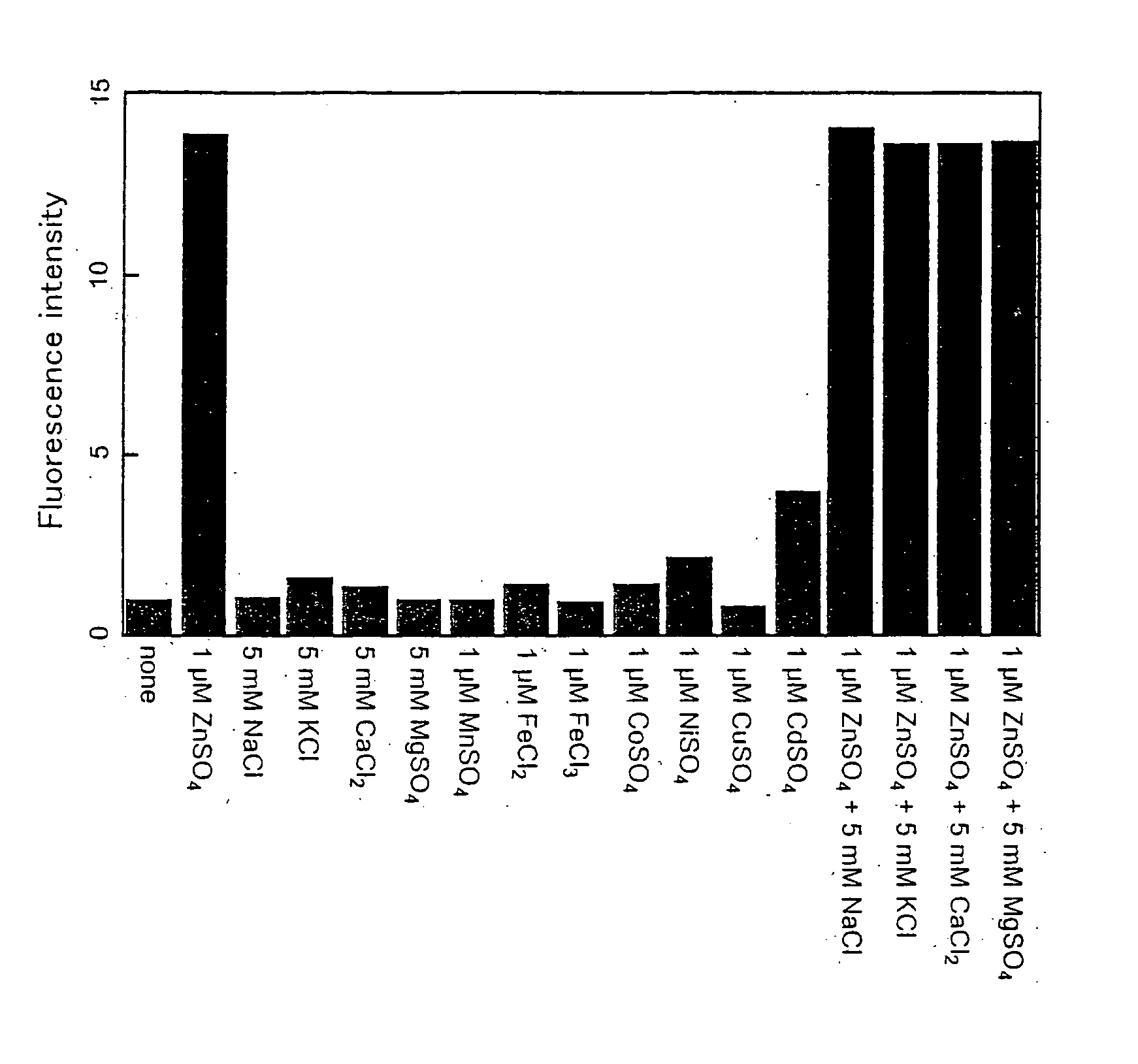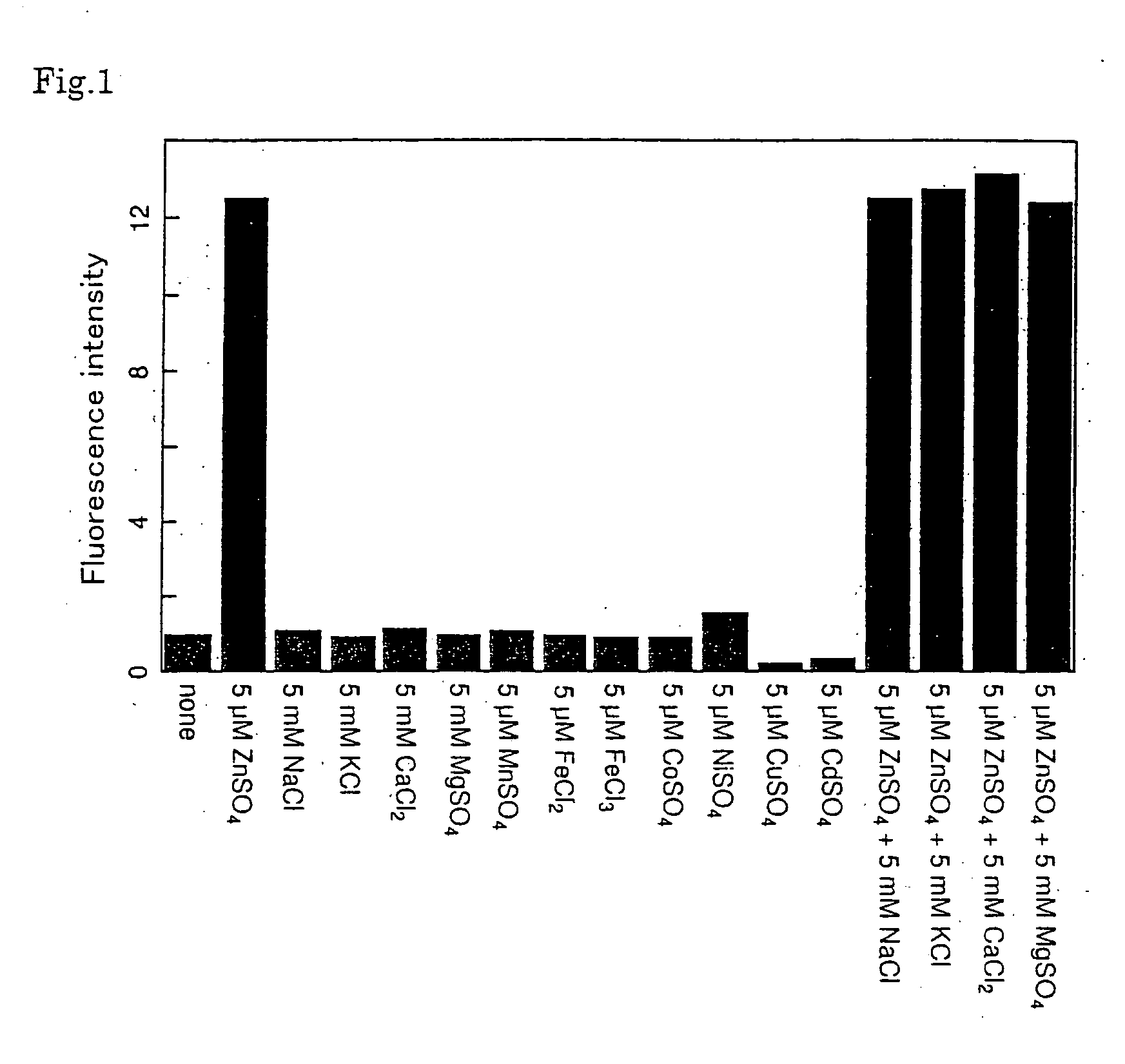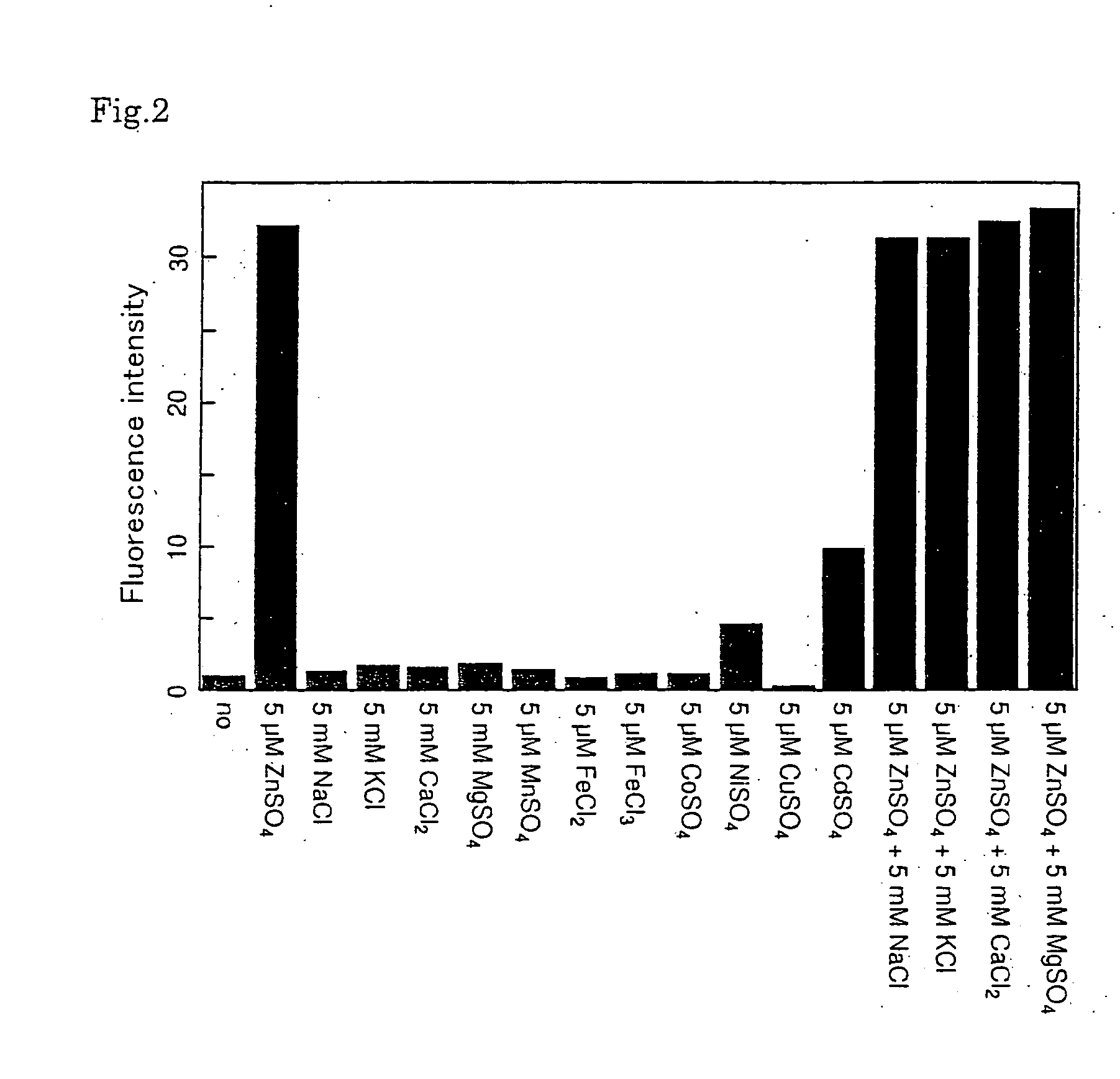Fluorescent probe for zinc
a fluorescence probe and zinc technology, applied in the direction of biocide, bulk chemical production, instruments, etc., can solve the problems of significant variation of fluorescence intensity, easy influence of measurement, damage to cells, etc., and achieve high specificity, high accuracy and sensitivity
- Summary
- Abstract
- Description
- Claims
- Application Information
AI Technical Summary
Benefits of technology
Problems solved by technology
Method used
Image
Examples
example 1
Synthesis of Compound 6
Cesium carbonate (5.2 g, 16 mmol) was added to a solution of 4-aminofluorescein (1) (2.5 g, 7.2 mmol) dissolved in 50 ml of dimethylformamide. Subsequently, pivaloyl anhydride (3.1 ml, 15 mmol) was added to this solution, and the mixture was stirred at room temperature for 1 hour. The reaction solution was filtered using a Kiriyama funnel, and dimethylformamide was evaporated under reduced pressure. The residue was purified by column chromatography on silica gel to obtain 3.6 g of Compound 2 (white solid, yield: 97%).
1H-NMR (CDCl3, 300 MHz): 7.19 (m, 1H), 7.02 (d, 2H, J=2.4), 6.93-6.94 (m, 2H), 6.88 (d, 2H, J=8.7), 6.77 (dd, 2H, J=8.7, 2.4), 4.06 (br, 2H), 1.34 (s, 18H)
MS (FAB): 516 (M++1)
m.p.: 206-208° C. (recrystallized from methanol)
Compound 2 (1.0 g, 2.0 mmol) was dissolved in 15 ml of pyridine and the solution was added with 4-nitrobenzenesulfonyl chloride (1.2 g, 5.3 mmol), and the mixture was then stirred at room temperature for 6 hours. Pyri...
example 2
Synthesis of Compound 12
Compound 8 (4.4 g) was obtained from 5-aminofluorescein (7) (3.5 g, 10 mmol) in the same manner as that of the synthesis of Compound 2 (white solid, yield: 84%).
1H-NMR (CDCl3, 300 MHz): 7.77 (d, 1H, J=7.9), 7.01 (d, 2H, J=2.0), 6.95 (d, 2H, J=8.6), 6.80-6.75 (m, 3H), 6.22 (d, 1H, J=1.7), 4.21 (br, 2H), 1.36 (s, 18H)
MS (FAB): 516 (M++1)
m.p.: 161-163° C. (recrystallized from methanol)
Compound 9 (4.1 g) was obtained from Compound 8 (3.6 g, 6.9 mmol) in the same manner as that of the synthesis of Compound 3 (white solid, yield: 84%).
1H-NMR (CDCl3, 300 MHz): 8.61 (br, 1H), 8.20 (d, 2H, J=9.0), 7.88 (d, 1H, J=8.3), 7.81 (d,.2H, J=9.0), 7.33-7.29 (m, 1H), 7.05 (d, 2H, J=2.2), 6.84 (d, 1H, J=1.8), 6.74 (dd, 2H, J=8.6, 2.2), 6.69 (d, 2H, J=8.6), 1.38 (s, 18H)
MS (FAB): 701 (M++1)
m.p.: 189-191° C. (recrystallized from ethyl acetate+n-hexane)
Compound 10 (0.35 g) was obtained from Compound 9 (0.51 g, 9.73 mmol) in the same manner as that of the-synthesis ...
example 3
Synthesis of Compound 15
4-Nitrophthalic anhydride (13) (16 g, 84 mmol) and 4-chlororesorcinol (14) (24 g, 0.17 mol) were dissolved in 250 ml of methanesulfonic acid, and the mixture was stirred under argon at 80° C. for 60 hours. The mixture was cooled to room temperature and then added in small portions to 1.4 L of ice water. The precipitated solid was collected by filtration to obtain 37 g of Compound 15 (quantitative yield).
Synthesis of Compound 16
Compound (15) (20 g, 45 mmol) was suspended in 700 ml of water, and the suspension was added with sodium sulfate nonahydrate (54 g, 0.23 mol) and sodium hydrosulfide n-hydrate (20g, 0.25 mol, about 70% of sodium hydrosulfide), and the mixture was refluxed under argon for 20 hours. After cooled to room temperature, the mixture was added with hydrochloric acid to adjust pH at 3 to 4. The precipitated solid was collected by filtration to obtain 19 g of Compound (16) (quantitative yield).
Synthesis of Compound 17
Compound (17) (3.9...
PUM
| Property | Measurement | Unit |
|---|---|---|
| excitation wavelength | aaaaa | aaaaa |
| excitation wavelength | aaaaa | aaaaa |
| excitation wavelength | aaaaa | aaaaa |
Abstract
Description
Claims
Application Information
 Login to View More
Login to View More - R&D
- Intellectual Property
- Life Sciences
- Materials
- Tech Scout
- Unparalleled Data Quality
- Higher Quality Content
- 60% Fewer Hallucinations
Browse by: Latest US Patents, China's latest patents, Technical Efficacy Thesaurus, Application Domain, Technology Topic, Popular Technical Reports.
© 2025 PatSnap. All rights reserved.Legal|Privacy policy|Modern Slavery Act Transparency Statement|Sitemap|About US| Contact US: help@patsnap.com



